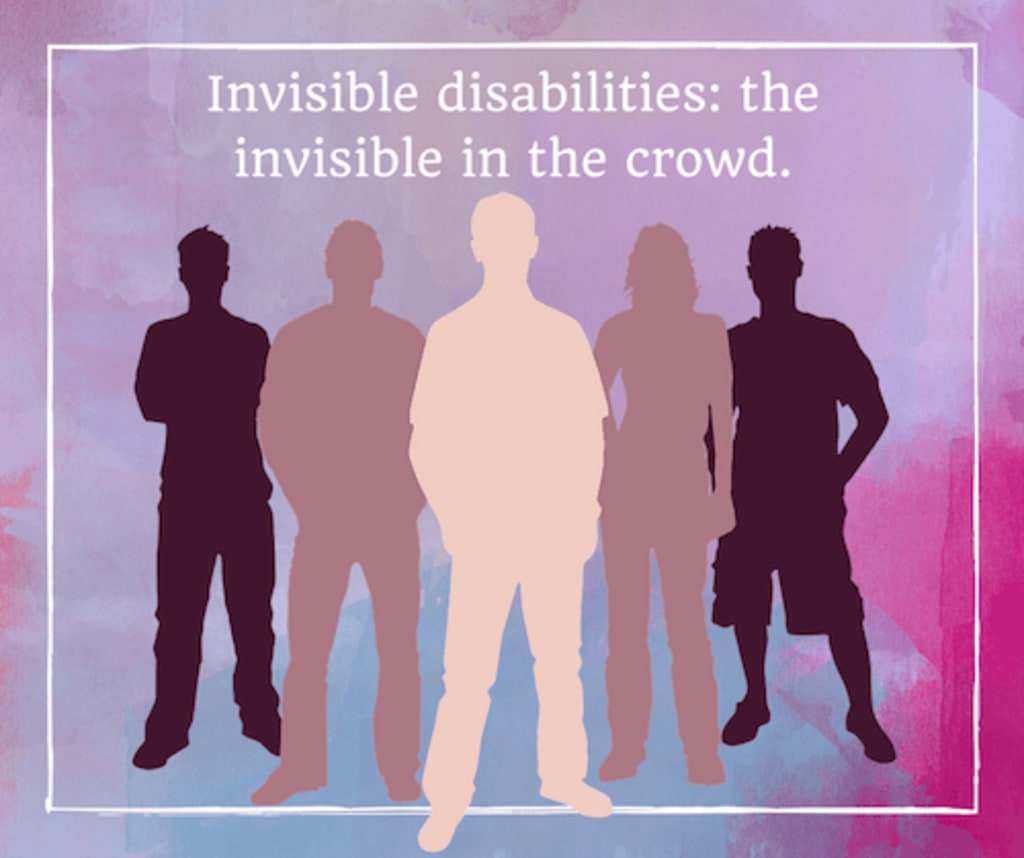6 Things to Know About Invisible Disability Awareness
This year Invisible Disability Awareness Week falls from October 18th to October 24th, 2020

"According to the Invisible Disabilities Association, the term invisible disability refers to symptoms such as debilitating pain, fatigue, dizziness, cognitive dysfunction, brain injuries, learning differences, mental health disorders, as well as hearing and visual impairments. They are not always obvious to the onlooker, but can sometimes or always limit daily activities range from mild challenges to severe limitations and vary from person to person" Invisible Disabilities You Should Know
Unseen
Because Invisible Disabilities are not visible to the eye it can cause issues. Some of these issues are judgments when we use disabled parking or disabled bathroom stalls and others feel the need to make an issue out of it… because we do not Look disabled.
1994-1995 Survey of Income and Program Participation (SIPP) found that 26 million Americans (almost 1 in 10) have a severe disability, while only 1.8 million used a wheelchair and 5.2 million used a cane, crutches or walker (Americans with Disabilities 94-95). In other words, 74% of Americans who live with a severe disability do not use such devices. Therefore, a disability cannot be determined solely by whether or not a person uses assistive equipment. -Invisible Disabilities Association
I use a cane for my vestibular condition, sometimes. Other times I do not. And when I do not I can stumble, weave, and sort of have trouble standing… I appear drunk and have been judged by people as such, when I am just dizzy and have no balance.
But that is another thing about disabilities- some of us have mobility aids that we do Not use all the time. Some of us do not use them at all. It can vary. Unseen to seen. To never seen at all.
Invisible Disabilities are more common than people think
Invisible disabilities are such symptoms as debilitating fatigue, pain, cognitive dysfunctions and mental disorders, as well as hearing and eyesight impairments and more. There are thousands of illnesses, disorders, diseases, dysfunctions, congenital disabilities, impairments, and injuries that can be debilitating. -Invisible Disabilities Association
1.5 billion people worldwide, for example, have chronic pain. That stat alone demonstrates a Whole lot of people have an invisible disability. Chances are people know someone with an invisible disability and do not even know it. Because we may choose for various reasons not to disclose it.
We look ‘fine’
We look fine on the outside and this is why it is called an Invisible disability. You can look at us and not see the disability. However, the impact on us can be quite severe. And if you know us, that impact might be seen… or not. And we may disclose our illness to you… or not.
If we do disclose our illness sometimes we get the ‘but you look Fine’ or ‘but you don’t Look sick’… like there is some One Defined WAY to Look sick. Or BE sick. Instead of thousands of ways people or sick are are sick. But people have preconceived notions of what a chronic illness Is and what it Should look like. And when we do not fit that notion we are faced with doubt or even denial we are chronically ill at all.

Often we face discrimination in the workforce
but in employment disability discrimination charges filed with the Equal Employment Opportunity Commission between 2005 and 2010, the most commonly cited conditions were invisible ones, according to analysis by researchers at Cornell University’s Employment and Disability Institute.
Joyce Smithey, a lawyer who specializes in labor and employment, says that’s not uncommon. When people with invisible disabilities request accommodations, Smithey says, some employers respond, “We don’t do that as a policy.”
“And that’s a problem,” Smithey says. “Because that person is not asking to partake of a benefit that’s offered in a policy; that person is asking for an accommodation they’re entitled to under the law.” -NPR
I was not offered accommodation because they didn’t believe my disability ‘fit the criteria for being disabled’ as in, I didn’t have a visible disability or a well-known disability… rather I had chronic pain that couldn’t be Seen or Known. So they refused all my suggestions for accommodation. And instead preferred threats, ultimatums, demotions… and so forth. Had I been the person I am now that would have been utterly unacceptable behavior… but I was passive and I blamed myself for so many things back then, sadly, so instead I just let them destroy my self-worth.
We choose whether to disclose we have a disability or not, and that can be a complicated choice
On the one hand, we can get the accommodations we require that help us function. On the other hand, it opens up to discrimination and bias.
Research suggests that there is a social stigma attached to having a disability, especially for psychological or psychiatric conditions (Jones et al., 1984; Stone & Colella, 1996). Some people with invisible disabilities might be willing to conceal their conditions and forego accommodations to avoid being treated differently or negatively by others. -Psychology Today
And sometimes judgement mean people question whether our disability is a valid one. I was told, for example, my disability (chronic pain at the time- fibromyalgia and chronic pain) were not considered a disability at all by my employer. But also other co-workers may think it isn’t considered valid. Or our co-workers may think we are slackers and just do not want to work at all.
others might assume the person is only trying to gain special privileges (Colella, 2001; Paetzold et al., 2008). In addition to dealing with the potential stigma associated with having a disability, persons with invisible disabilities risk the additional stigma of being viewed as someone who is falsely seeking personal gain. -Psychology Today
Other times, we ourselves may question whether our chronic illness or symptoms qualify as a disability. For a long time, I didn’t think so even though it severely compromised my ability to function and work. I thought I was flawed in my capacity to cope and push through the pain.
It can take a long time, years, to get a diagnosis
Invisible conditions are also more difficult to detect by healthcare providers, leading many such conditions to go undiagnosed or be misdiagnosed. Research has reported that the process of being diagnosed with a learning disability often involves collecting multiple conflicting diagnoses by healthcare providers over a long period of time (Higgins, Raskind, Goldberg, & Herman, 2002). Making matters more complicated, the clinical criteria for some conditions might change over time. -Psychology Today
This is a frustration I am still dealing with to this day with other diagnoses. Waiting and waiting, the tests and more tests… and for what? It takes years and years for a diagnosis. Years of not working and no treatment and fighting for insurance payments.
Why is awareness important?
Other than the above points, it should be noted stigma and discrimination is extremely damaging and pervasive. People with a mental illness flippantly called ‘crazy’ and ‘unstable’. People with chronic pain called ‘lazy’ and ‘drug seekers’. People who are disabled ‘mooching off the system because they don’t want to work’. All of these cause a lot of harm to us mentally and emotionally. Not to mention the subtle and not so subtle ways employers try to push people with invisible disabilities out of their place of employment because they simply do not want them there. Or do not provide accommodations because they simply do not feel like it. It can make for a very toxic, hostile work environment and that stress level can be very damaging mentally and emotionally.
Yet if we do not disclose our disabilities, it causes equal harm to us with the levels of stress we have to deal with… the ‘fake it till you make it’ and pushing through it, when we can’t do it… making ourselves sicker to do so. Causing a lot more harm in the process but we know what happens when we disclose and we do not want That Either.
Obviously, the ideal solution is raising awareness and reducing the stigma of invisible disabilities. One would hope in the future this becomes possible and people understand that invisible disabilities are very common. People are likely to know someone who has to deal with one. People likely know someone who deals with one that severely reduces their ability to function in many ways. Maybe they know that. Maybe they don’t know that. But that person is there regardless. Dealing with their disability and not needing the validation from others in order to do so. Whether people believe us or not doesn’t change our reality… we still have to deal with our disability, they just make our lives so much harder. They can make the workplace hellish. Doctors can compromise our treatment. Friends can minimize our reality we deal with. People can doubt our disability and judge us for using a disability parking spot… and harass us. Society can just not make Space for us and expect us to function like normal people because we ‘look fine’.
Originally posted on my blog- Brainless Blogger
About the Creator
Nikki Albert
I'm a fiction writer under the pen name Lily Hamilton and a blogger under my name. I live in Alberta, Canada with my common-law spouse and my cat. I'm currently on disability with fibromyalgia, chronic migraine disease and chronic vertigo






Comments
There are no comments for this story
Be the first to respond and start the conversation.